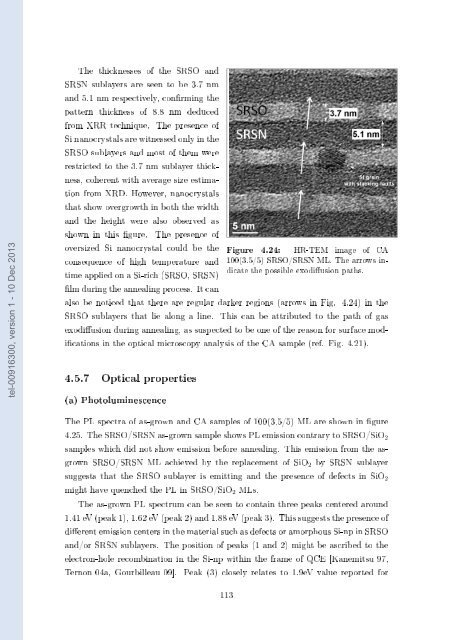Films minces à base de Si nanostructuré pour des cellules ...
Films minces à base de Si nanostructuré pour des cellules ...
Films minces à base de Si nanostructuré pour des cellules ...
You also want an ePaper? Increase the reach of your titles
YUMPU automatically turns print PDFs into web optimized ePapers that Google loves.
tel-00916300, version 1 - 10 Dec 2013<br />
The thicknesses of the SRSO and<br />
SRSN sublayers are seen to be 3.7 nm<br />
and 5.1 nm respectively, conrming the<br />
pattern thickness of 8.8 nm <strong>de</strong>duced<br />
from XRR technique. The presence of<br />
<strong>Si</strong> nanocrystals are witnessed only in the<br />
SRSO sublayers and most of them were<br />
restricted to the 3.7 nm sublayer thickness,<br />
coherent with average size estimation<br />
from XRD. However, nanocrystals<br />
that show overgrowth in both the width<br />
and the height were also observed as<br />
shown in this gure. The presence of<br />
oversized <strong>Si</strong> nanocrystal could be the<br />
consequence of high temperature and<br />
time applied on a <strong>Si</strong>-rich (SRSO, SRSN)<br />
lm during the annealing process. It can<br />
Figure 4.24: HR-TEM image of CA<br />
100(3.5/5) SRSO/SRSN ML. The arrows indicate<br />
the possible exodiusion paths.<br />
also be noticed that there are regular darker regions (arrows in Fig. 4.24) in the<br />
SRSO sublayers that lie along a line. This can be attributed to the path of gas<br />
exodiusion during annealing, as suspected to be one of the reason for surface modications<br />
in the optical microscopy analysis of the CA sample (ref. Fig. 4.21).<br />
4.5.7 Optical properties<br />
(a) Photoluminescence<br />
The PL spectra of as-grown and CA samples of 100(3.5/5) ML are shown in gure<br />
4.25. The SRSO/SRSN as-grown sample shows PL emission contrary to SRSO/<strong>Si</strong>O 2<br />
samples which did not show emission before annealing. This emission from the asgrown<br />
SRSO/SRSN ML achieved by the replacement of <strong>Si</strong>O 2 by SRSN sublayer<br />
suggests that the SRSO sublayer is emitting and the presence of <strong>de</strong>fects in <strong>Si</strong>O 2<br />
might have quenched the PL in SRSO/<strong>Si</strong>O 2 MLs.<br />
The as-grown PL spectrum can be seen to contain three peaks centered around<br />
1.41 eV (peak 1), 1.62 eV (peak 2) and 1.88 eV (peak 3). This suggests the presence of<br />
dierent emission centers in the material such as <strong>de</strong>fects or amorphous <strong>Si</strong>-np in SRSO<br />
and/or SRSN sublayers. The position of peaks (1 and 2) might be ascribed to the<br />
electron-hole recombination in the <strong>Si</strong>-np within the frame of QCE [Kanemitsu 97,<br />
Ternon 04a, Gourbilleau 09]. Peak (3) closely relates to 1.9eV value reported for<br />
113
















